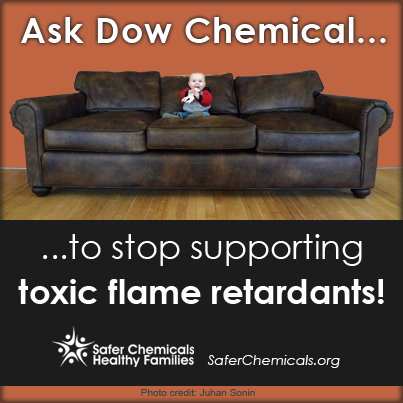When Herbert H. Dow tapped the bromine salt deposits beneath Midland, Michigan, he launched a major chemical company and the chemistry that, more than a century later, still haunts our homes and bodies with toxic flame retardants.
Scientists shed new light on this growing chemical threat just last week, with two research teams reporting results in
the prestigious peer-reviewed journal Environmental Science & Technology.
One study found that 85% of couches sampled has high levels of brominated and chlorinated flame retardants known to cause cancer, hormone disruption or reproductive harm. Some are long-lived in the environment, building up to high levels in wildlife and people.
Jenny Rottmann, a pregnant study participant who provided a foam sample from her couch cushion, responded this way: “It’s something that I’d be concerned about no matter what, but finding this out a couple days before I’m about to deliver a baby really is infuriating to me.”
The other study revealed that people are exposed to flame retardants in their homes everyday, often at levels that exceed federal health guidelines. Researchers found 44 flame retardant chemicals in household dust, which people breathe and ingest, especially small children with their
frequent hand-to-mouth contact.
The chemical industry has aggressively covered up the dangers and exaggerated the effectiveness of toxic flame retardants in slowing the spread of household fires. Three small chemical companies have drawn the most heat. According to the Chicago Tribune, Albemarle, Chemtura, and ICL used misleading testimony, phony front groups and distorted science to expand and protect
their chemical markets.
Little noticed so far has been the role that heavyweight chemical corporations such as Dow Chemical play in
propping up the toxic flame retardant industry. Dow places a heavy thumb on the toxic scale in two ways.
First, they sit at the base of the supply chain, producing the chemicals needed to make a broad class of
chlorinated flame retardants. Dow Chemical is the world’s largest producer of chlorine and epichlorohydrin, and also makes phosphorus oxychloride. These three
chemicals are essential raw materials for the production of chlorinated tris (also known as TDCPP) and related chlorinated flame retardants.
In the recent science studies, TDCPP was found in 42% of all couches, more often than any other flame retardant chemical, and in 100% of household dust samples. The U.S. Environmental Protection Agency considers TDCPP a hazard for “cancer, reproductive harm, developmental toxicity, systemic toxicity, and genotoxicty in humans; and ecotoxicity and environmental
persistence.” Last year, California
concluded that TDCPP was known to cause cancer.
That’s why Safer Chemicals, Healthy Families asked Dow Chemical today to show its commitment to truly sustainable chemistry by agreeing not to sell its chemical raw materials for use in the manufacture of chlorinated tris. As the SCHF letter said:
” … from your powerful position at the base of the supply chain, you would send an important signal to the marketplace that fire safety goals should be met with safer alternatives to the use of TDCPP.”
Hopefully, Dow Chemical will respond more quickly and positively to this leadership opportunity than they
have on a second, more systemic front.
The major chemical companies, including Dow Chemical, have perpetuated our broken federal chemical safety system for thirty-six years running. The obsolete Toxic Substances Control Act of 1976 (TSCA) keeps the public in the dark about chemical hazards and handcuffs the federal government from restricting known chemical dangers.
Last year, Dow Chemical management broke off negotiations that were heading toward a compromise TSCA reform
agreement. The company has maintained steadfast opposition to the Safe Chemicals Act, despite widespread public and political support for tighter regulation of toxic chemicals in everyday products.
Dow Chemical, which spouts “solutionism” and “sustainability” as marketing mantra, has been trying hard to shake off the toxic legacy of Agent Orange and dioxin. And despite
their positive spin, Dow remains wedded to chlorine chemistry (some call it ‘Pandora’s Poison’), which it uses to make more than one-quarter of more than 5,000
Dow products.
No one expects Dow Chemical to transform itself into a green chemistry company anytime soon. Dow’s current goal remains extremely modest – at least 10% of their sales will consist of products highly advantaged by sustainable chemistry, broadly defined, by 2015.
Yet, Dow does have a chance to be a real leader on the path to more sustainable, inherently safer chemistry. It’s time for Dow Chemical to get off the toxic couch by actively opposing the home invasion by chlorinated tris, and
supporting the Safe Chemicals Act.
Read our press release and follow Mike on Twitter: @preventharm




